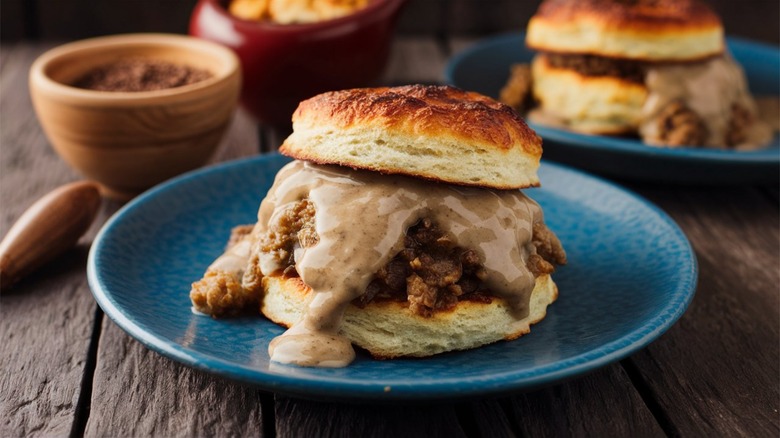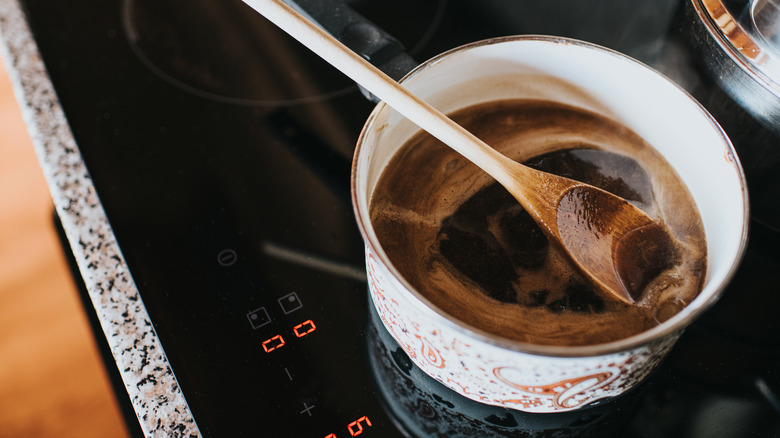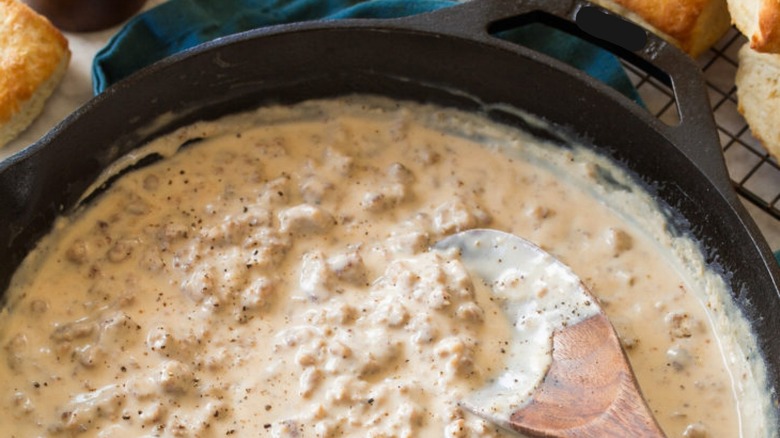The Best Way To Thicken Gravy Is Also The Easiest
Smooth, savory, and packed with seasoning, gravy can transform simple meals into mouthwatering ones. From buttermilk biscuits with sausage cream gravy to roasted Thanksgiving turkey, the staple sauce is bound to grace your table at some point throughout the year. Whether you prefer a well-seasoned meat-based gravy or an umami-rich version made with mushrooms, it's simple to make, requiring only a few ingredients. However, the sauce is much more difficult to perfect — especially when it comes to consistency.
Gravy is often prepared by mixing a roux, which combines flour and fat to create a rich, thick base for sauces, with flavorful stock, broth, or meat drippings. But nailing its texture can be tricky, as flour can lead to some gravy-making mistakes. If it's too runny, for instance, watery gravy will soak fresh, fluffy biscuits or pool up underneath meat and mashed potatoes. Instead of enjoying a meal evenly coated in a savory sauce, your plate of food might end up a sopping wet mess. Fortunately, there are tried-and-true methods to thicken gravy, although not all of them are created equal.
Some online sources suggest grabbing a whole new pot to cook another roux and carefully whisk it into the sauce, while others call for ingredients like arrowroot that you might not have handy in your pantry. However, the best way to thicken gravy is simpler than you might think. Before you bust out the cornstarch or more flour, consider giving the sauce a little extra time on the stove.
Simmer gravy on the stovetop for longer
Part of the difficulty of preparing gravy is figuring out when it's finished cooking. Many recipes call for the sauce to come off of heat right before you think it's done, as it should finish thickening up more as it cools. But it can be hard to nail the timing precisely. So, if you've followed the instructions perfectly and your gravy is still a little more runny than you'd like, the easiest way to thicken it is to simply let it simmer, uncovered, on the stovetop for longer.
Thickening gravy by letting time and heat do the heavy lifting while you stir it occasionally allows some of the excess liquid to evaporate from the sauce without adding in any new ingredients. This technique, known as reducing, is commonly used to thicken pasta sauce or fruit-based glazes, such as an aptly named strawberry balsamic reduction. The main downside of simmering gravy until it's thick enough, ideally to the point that it can coat the back of a spoon, is that it can take a while.
Additionally, if the sauce starts out so watery that it's practically a broth, reducing it to the right consistency might make it too concentrated. A slightly more complicated thickening method, such as mixing together and adding a cornstarch slurry, could be better-suited to the task in this situation. Fortunately, it's just as easy to fix a gravy that ends up overly salty or even thickened too well.
How to save a gravy that's thickened too much
Whether you've taken your eye off of the saucepan or were trying to improve a canned sausage gravy by tweaking its consistency slightly, it's easy to simmer the sauce to the point that it's too thick or the flavor is overly strong and savory. The good news is that this instance of suffering from success is just as easily remedied. All you'll need to do to thin it out or resolve any excess saltiness is add some liquid back into the gravy.
If you're working with a cream-based gravy, mixing in a splash of milk or cream will complement the sauce's richness, temper any saltiness, and thin out the sauce a little. If you're working with a brown gravy, either made from turkey fat drippings or vegetable stock, simply pour in some unsalted broth. This will also help introduce some liquid back into a sauce that's just a bit too thick and weaken any overly strong flavors. Both alternatives are better than plain water as they stay more true to the gravy's desired taste and don't risk diluting it too much.
While achieving a gravy's ideal flavor and consistency might require some trial and error, sticking with the stovetop and the ingredients already in the sauce is the simplest way to strike the perfect balance. And unlike other thickening methods, you won't have to worry about lumps (and potentially straining out the much-needed starch) or cooking another roux.


